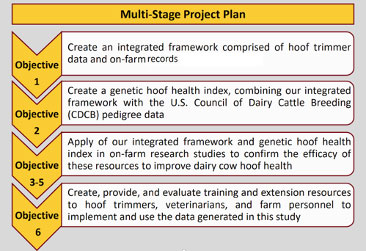
About 50% of dairy cows will be affected by lameness during their productive life, resulting in economic losses, poor health, and suboptimal animal welfare. With hoof horn lesions as the second-leading cause of lameness, a group led by the Council on Dairy Cattle Breeding (CDCB) is researching genetic solutions to improve cow mobility.
CDCB, the University of Minnesota, and several collaborators are working to better understand the potential of genetics and create a pipeline for hoof health data collection. That data pipeline is the essential first step to develop genetic evaluations for hoof health-related traits.
CDCB, Minnesota leading the charge
CDCB is facilitating the new project, “Reducing lesion-related lameness using a combination of epidemiological, genomic and extension approaches,” in conjunction with University of Minnesota Extension and College of Veterinary Medicine.
Expectations of this new study, being led by veterinarian Gerard Cramer at University of Minnesota, include:
- Improved understanding of causal factors related to hoof horn disorders.
- Use of an integrated database as a novel welfare assessment tool for lameness.
- Application of the database in future research to aid in development of intervention treatments for hoof horn lesions.

Planning for this initiative began at a comprehensive workshop in September 2020 facilitated by CDCB with representatives from USDA AGIL, University of Minnesota, Lactanet (Canada), Hoof Trimmers Association, University of Calgary, Dairy Management Inc., and Foundation for Food and Agriculture Research.
Building the data pipeline for genetic evaluations
In the U.S., there are approximately 1,100 hoof trimmers providing preventive and therapeutic care for approximately 9.3 million dairy cows. Using the USDA estimate that 64% of cows undergo 1.5 regular preventive trimmings per year, it could be expected that there are around 9 million preventive hoof trimming sessions taking place every year.
Based on these statistics, there is a realistic opportunity to collect enough hoof health records, or phenotypes, to develop genetic prediction models that will help dairy farmers to select cows that can better resist hoof and locomotion problems. Furthermore, a hoof health data pipeline will support development of management tools to improve efficiency of hoof preventive care and enhance dairy cow health.
Hoof health data will be collected by hoof trimmers and farm managers trained through the CDCB-UMN project. Lameness data will also be captured using a Video Analytic Platform (VAP) capable of analyzing digital locomotion images to assign lameness scores to dairy cows. Key collaborators are the digital technology company that designed and operates the VAP and dairy farms that are providing lameness and hoof health data.
Learn more
“Improving cow mobility through genetics” is the theme of the CDCB industry meeting, on Wednesday, October 20, from 2 to 4 p.m. (Eastern) via Zoom. This interactive session with researchers and project partners will describe the genetic opportunity and this new project to measure and evaluate hoof health and lameness in dairy cows. Click here to register for the CDCB meeting.
For more on the lesion-related lameness study by CDCB-UMN, click here.Javier Burchard, is chief innovation officer at the Council on Dairy Cattle Breeding, Bowie, Maryland.






